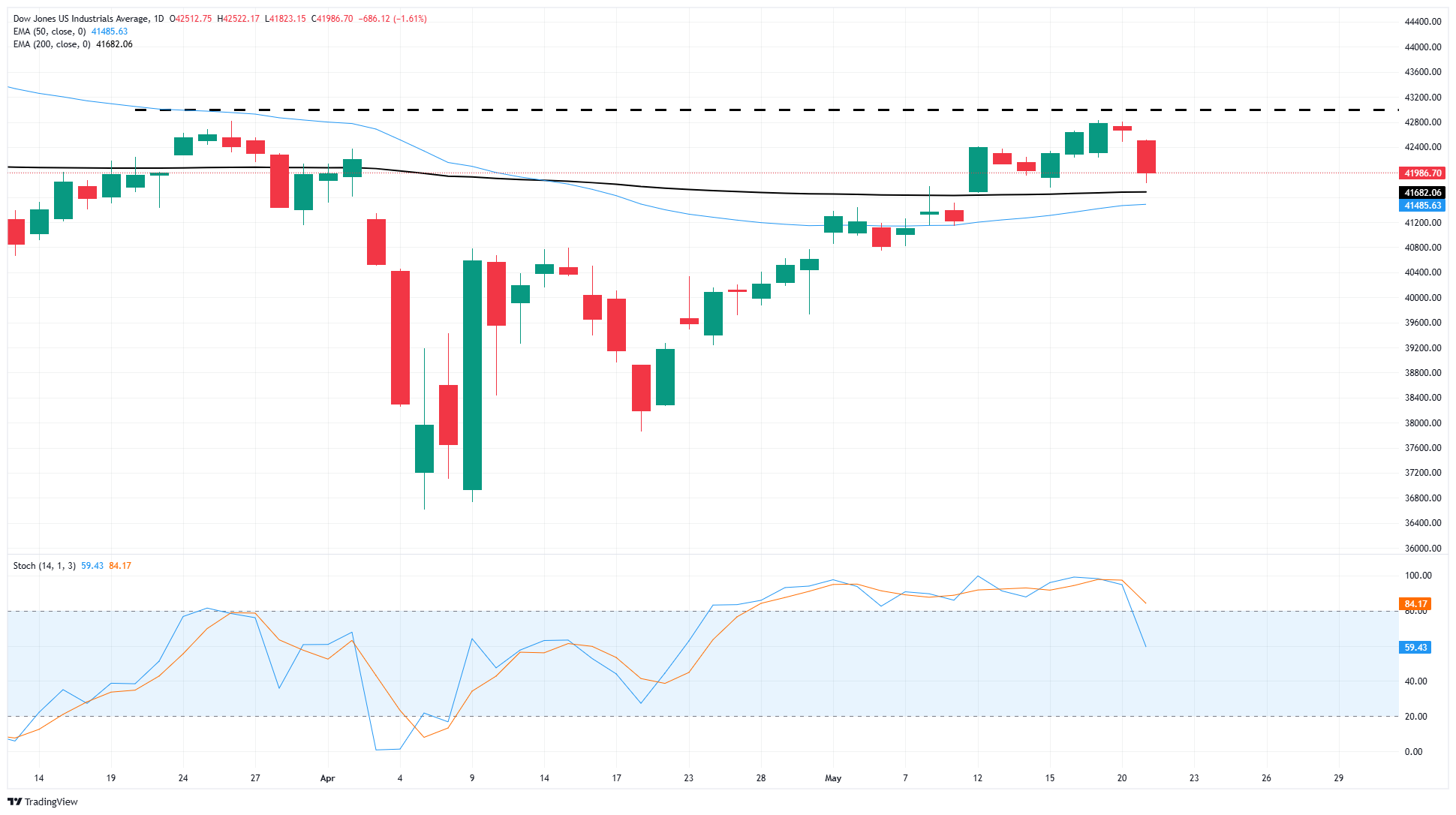Created
: 2025.05.22














![]() 2025.05.22 02:55
2025.05.22 02:55
The Dow Jones Industrial Average (DJIA) recoiled on Wednesday, tumbling 800 and testing below 42,000 after demand for United States (US) Treasuries declined. Financial markets are showing waning interest and confidence in US debt financing, even with 20-year Treasury bonds offering a yield north of 5% for the first time since October of 2023. The bid-to-cover on 16B worth of 20-year Treasuries fell below its six-month average of 2.57, slipping to 2.46 and sending market sentiment into a brief tailspin.
The US government inches closer to approving US President Donald Trump's "big, beautiful budget" that will add almost four trillion dollars to the US deficit over the next decade. The deficit-swelling budget comes less than a week after Moody's downgraded US sovereign debt, citing long-running failures by the US government to reel in government spending or sufficiently increase tax receipts.
Investor hopes for another rate cut from the Federal Reserve (Fed) continue to get pushed further out this year. According to Fed policymakers, the looming threat that US tariffs could reignite inflation and throw a wrench in US economic growth is limiting their ability to adjust policy rates as they wait for clear data. The Trump administration is barreling towards the end of its own "reciprocal tariffs" suspension deadline, and evidence of ink-on-paper trade deals remains functionally non-existent. With the future of US trade policy muddying the waters, rate traders are now split on whether the Fed will deliver its first quarter-point rate cut in September or October.
Read more stock news: US stock market slips despite Republicans inching closer to major tax cuts
Fundamentals have bled through the chart paper, taking over market dynamics as investors react to headlines about trade and federal budgets. The Dow Jones Industrial Average is still trading above the 200-day Exponential Moving Average (EMA) near 41,570, at least for now. Bullish price action continues to have the wind knocked out of its sails, and buyers have thus far struggled to muscle the major equity index back to the 43,000 handle.

The Dow Jones Industrial Average, one of the oldest stock market indices in the world, is compiled of the 30 most traded stocks in the US. The index is price-weighted rather than weighted by capitalization. It is calculated by summing the prices of the constituent stocks and dividing them by a factor, currently 0.152. The index was founded by Charles Dow, who also founded the Wall Street Journal. In later years it has been criticized for not being broadly representative enough because it only tracks 30 conglomerates, unlike broader indices such as the S&P 500.
Many different factors drive the Dow Jones Industrial Average (DJIA). The aggregate performance of the component companies revealed in quarterly company earnings reports is the main one. US and global macroeconomic data also contributes as it impacts on investor sentiment. The level of interest rates, set by the Federal Reserve (Fed), also influences the DJIA as it affects the cost of credit, on which many corporations are heavily reliant. Therefore, inflation can be a major driver as well as other metrics which impact the Fed decisions.
Dow Theory is a method for identifying the primary trend of the stock market developed by Charles Dow. A key step is to compare the direction of the Dow Jones Industrial Average (DJIA) and the Dow Jones Transportation Average (DJTA) and only follow trends where both are moving in the same direction. Volume is a confirmatory criteria. The theory uses elements of peak and trough analysis. Dow's theory posits three trend phases: accumulation, when smart money starts buying or selling; public participation, when the wider public joins in; and distribution, when the smart money exits.
There are a number of ways to trade the DJIA. One is to use ETFs which allow investors to trade the DJIA as a single security, rather than having to buy shares in all 30 constituent companies. A leading example is the SPDR Dow Jones Industrial Average ETF (DIA). DJIA futures contracts enable traders to speculate on the future value of the index and Options provide the right, but not the obligation, to buy or sell the index at a predetermined price in the future. Mutual funds enable investors to buy a share of a diversified portfolio of DJIA stocks thus providing exposure to the overall index.
![]()
Created
: 2025.05.22
![]()
Last updated
: 2025.05.22

FXStreet is a forex information website, delivering market analysis and news articles 24/7.
It features a number of articles contributed by well-known analysts, in addition to the ones by its editorial team.
Founded in 2000 by Francesc Riverola, a Spanish economist, it has grown to become a world-renowned information website.
We hope you find this article useful. Any comments or suggestions will be greatly appreciated.
We are also looking for writers with extensive experience in forex and crypto to join us.
please contact us at [email protected].
Disclaimer:
All information and content provided on this website is provided for informational purposes only and is not intended to solicit any investment. Although all efforts are made in order to ensure that the information is correct, no guarantee is provided for the accuracy of any content on this website. Any decision made shall be the responsibility of the investor and Myforex does not take any responsibility whatsoever regarding the use of any information provided herein.
The content provided on this website belongs to Myforex and, where stated, the relevant licensors. All rights are reserved by Myforex and the relevant licensors, and no content of this website, whether in full or in part, shall be copied or displayed elsewhere without the explicit written permission of the relevant copyright holder. If you wish to use any part of the content provided on this website, please ensure that you contact Myforex.
Myforex uses cookies to improve the convenience and functionality of this website. This website may include cookies not only by us but also by third parties (advertisers, log analysts, etc.) for the purpose of tracking the activities of users. Cookie policy